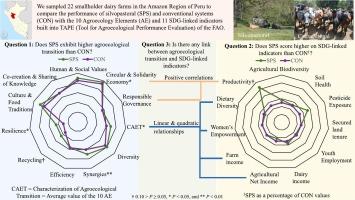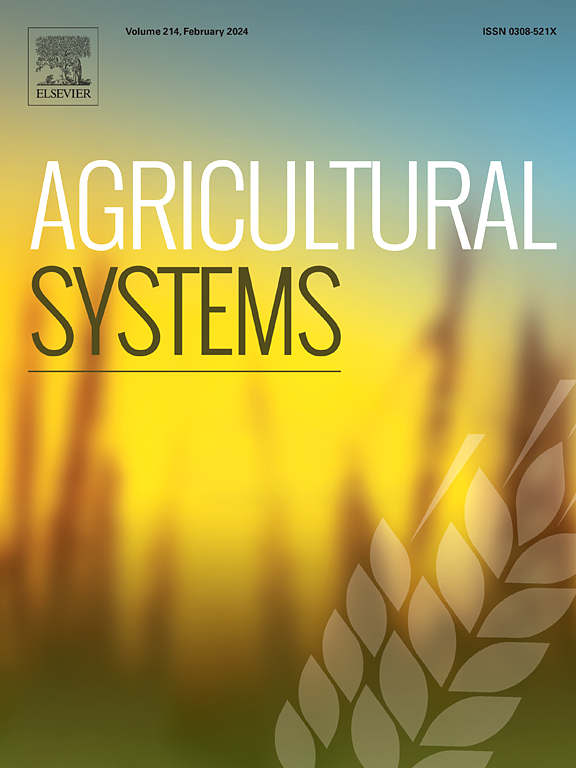秘鲁亚马逊地区小农奶牛系统的农业生态效益
IF 6.1
1区 农林科学
Q1 AGRICULTURE, MULTIDISCIPLINARY
引用次数: 0
摘要
内容提要在秘鲁,林牧系统已被列为解决森林砍伐和减少碳排放的一项国家措施。目的我们使用农业生态绩效评估工具(TAPE)评估了秘鲁亚马逊地区小农奶牛场的可持续性受系统类型(林牧或传统)和牧群规模(中型或大型)的影响。此外,我们还探讨了 TAPE 指标之间的联系,包括 10 个生态农业要素 (EA)、一个总体评价量表(生态农业转型特征;CAET)和 11 个与可持续发展目标相关的绩效核心标准 (CCP)。结果和结论无论牧群规模如何,与传统系统相比,草牧业系统的农业生态过渡程度更高(69.0 比 60.2;CAET 平均值)。结果表明,如果假定线性关系,EA 和 CCP 基本上是相互独立的。然而,在 CAET 和 4 个 CCP 之间发现了凹二次关系:农场收入、农业纯收入、膳食多样性和妇女赋权。就这些 CCP 而言,CAET 值处于中等水平(60 至 69)的农场的低值表明,它们既没有获得主要在林牧农场(CAET >70)中发现的生态农业实践的全部益处,也没有获得传统实践(CAET <60)的全部益处。本文章由计算机程序翻译,如有差异,请以英文原文为准。

Agroecological performance of smallholder dairy cattle systems in the Peruvian Amazon
CONTEXT
In Peru, silvopastoral systems have been included as a national measure to address deforestation and mitigate carbon emissions. Limited studies have assessed the sustainability of mixed livestock-crop systems using tools that address multiple Sustainable Development Goals (SDG).
OBJECTIVE
We assessed the sustainability of smallholder dairy farms in the Peruvian Amazon as affected by system type (silvopastoral or conventional) and herd size (medium or large) using the Tool for Agroecological Performance Evaluation (TAPE). Furthermore, we explored the linkages among TAPE indicators including the 10 Elements of Agroecology (EA), an overall evaluation scale (Characterization of Agroecological Transition; CAET), and 11 SDG-linked Core Criteria of Performance (CCP).
METHODS
Twenty-two farmers of the San Martin region were surveyed. Data were subjected to analysis of variance, Pearson correlations, and fitted to linear and quadratic functions.
RESULTS AND CONCLUSIONS
Silvopastoral systems showed a greater agroecological transition than conventional systems (69.0 vs. 60.2; CAET mean) regardless of herd size.
Results suggested that EA and CCP were essentially independent of each other if linearity was assumed. However, concave quadratic relationships were detected between the CAET and 4 CCP: Farm Income, Agricultural Net Income, Dietary Diversity, and Women's Empowerment. For these CCP, depressed values for farms with intermediate CAET (60 to 69) suggested that they neither reap the full benefits of agroecological practices found mainly in silvopastoral farms (CAET >70) nor the full benefits of conventional practices (CAET <60).
SIGNIFICANCE
The implementation of agroecological practices in smallholder systems may support positive economic and social sustainability outcomes.
求助全文
通过发布文献求助,成功后即可免费获取论文全文。
去求助
来源期刊

Agricultural Systems
农林科学-农业综合
CiteScore
13.30
自引率
7.60%
发文量
174
审稿时长
30 days
期刊介绍:
Agricultural Systems is an international journal that deals with interactions - among the components of agricultural systems, among hierarchical levels of agricultural systems, between agricultural and other land use systems, and between agricultural systems and their natural, social and economic environments.
The scope includes the development and application of systems analysis methodologies in the following areas:
Systems approaches in the sustainable intensification of agriculture; pathways for sustainable intensification; crop-livestock integration; farm-level resource allocation; quantification of benefits and trade-offs at farm to landscape levels; integrative, participatory and dynamic modelling approaches for qualitative and quantitative assessments of agricultural systems and decision making;
The interactions between agricultural and non-agricultural landscapes; the multiple services of agricultural systems; food security and the environment;
Global change and adaptation science; transformational adaptations as driven by changes in climate, policy, values and attitudes influencing the design of farming systems;
Development and application of farming systems design tools and methods for impact, scenario and case study analysis; managing the complexities of dynamic agricultural systems; innovation systems and multi stakeholder arrangements that support or promote change and (or) inform policy decisions.
 求助内容:
求助内容: 应助结果提醒方式:
应助结果提醒方式:


